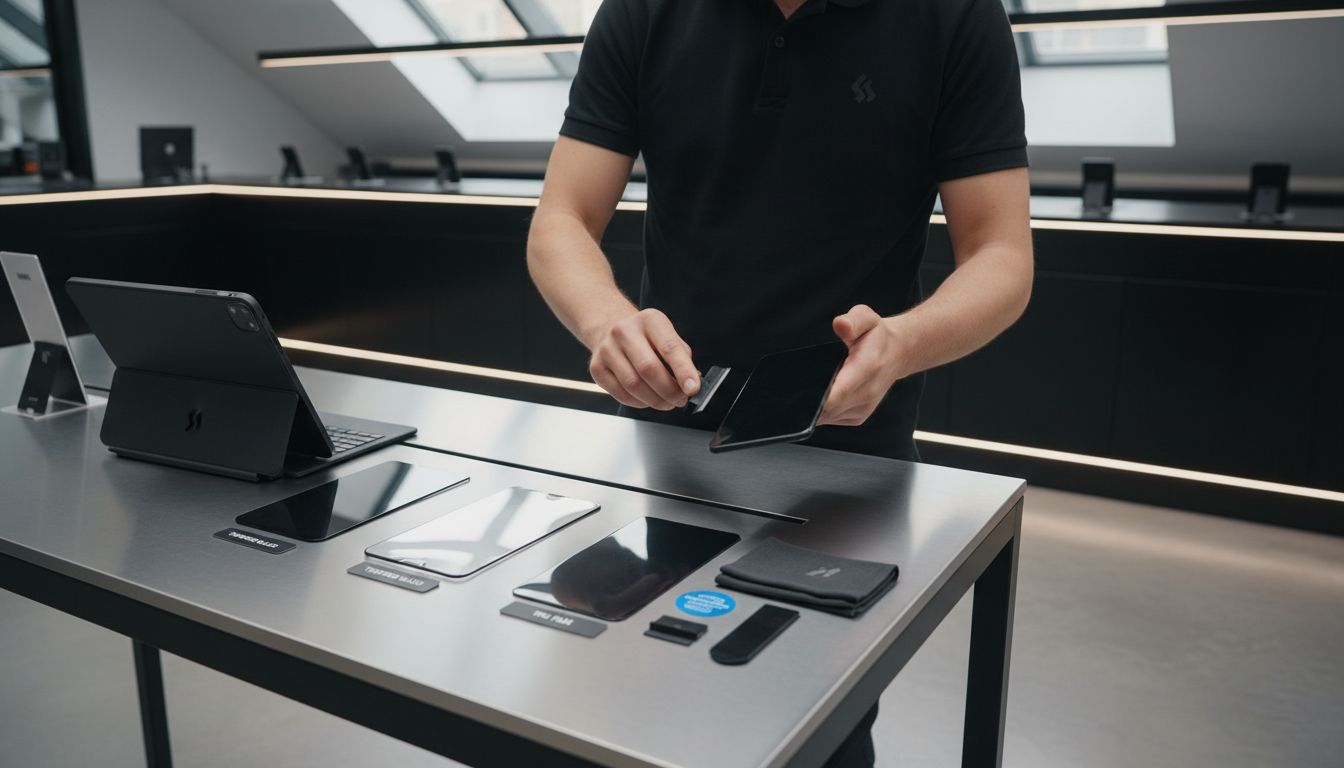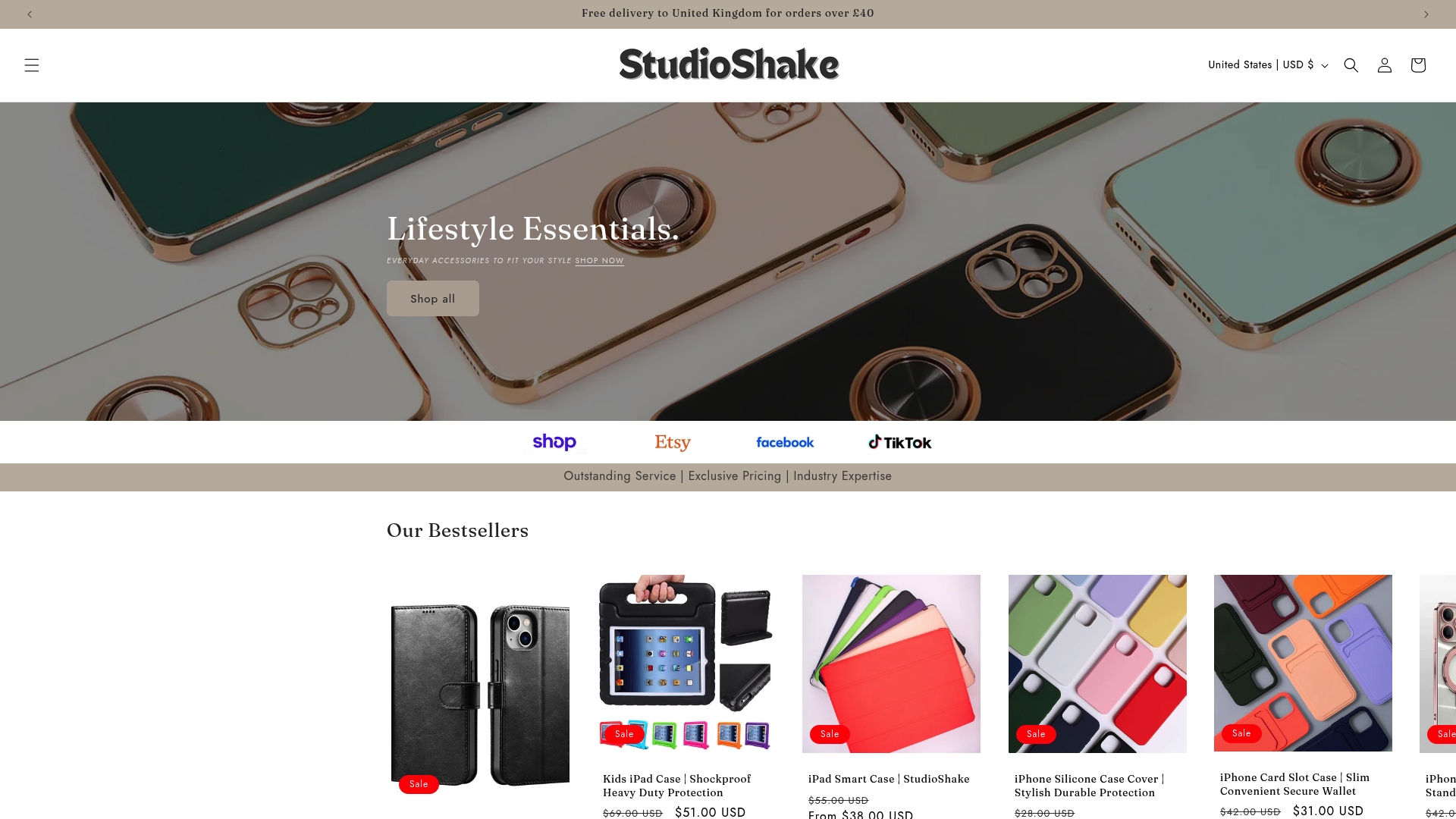
Complete Guide to Mobile Screen Protectors
Share
A single drop can cost you hundreds in repairs, but more than 25 percent of smartphone users experience accidental screen damage each year. As devices grow sleeker and more expensive, even a simple scratch can affect performance and resale value. Choosing the right mobile screen protector is not just about guarding your phone—it is a smart way to extend its life and avoid frustrating mishaps. Discover how these small accessories can deliver peace of mind and practical savings.
Table of Contents
- What Are Mobile Screen Protectors?
- Types Of Screen Protectors Available
- How Screen Protectors Safeguard Devices
- Comparing Protectors To Other Solutions
- Common Mistakes When Using Protectors
Key Takeaways
| Point | Details |
|---|---|
| Screen Protectors | Mobile screen protectors are essential for safeguarding devices, available in materials like tempered glass, PET, and TPU, each offering varying levels of protection. |
| Importance of Protection | Utilizing a screen protector can prevent costly repairs by serving as a barrier against scratches, cracks, and daily wear. |
| Proper Installation | Correct application is crucial; failure to follow installation guidelines can lead to air bubbles and reduced functionality. |
| Comparison with Alternatives | Screen protectors are often more cost-effective than professional repairs, insurance, or DIY solutions with hidden risks. |
What Are Mobile Screen Protectors?
Mobile screen protectors are thin layers of protective material designed to shield your smartphone or tablet’s display from scratches, cracks, and everyday wear and tear. According to Wikipedia, a screen protector is an “additional sheet of material, commonly made from polyurethane or laminated glass, that can be attached to the screen of an electronic device to protect it against physical damage”.
These protective films act as a sacrificial barrier between your device’s delicate touchscreen and potential hazards like keys, coins, sharp objects, and accidental drops.
 Screen protectors come in various materials and styles, each offering different levels of protection. The primary types include:
Screen protectors come in various materials and styles, each offering different levels of protection. The primary types include:
- Tempered glass protectors: Hardened glass offering superior scratch and impact resistance
- Plastic film protectors: Thin, flexible options providing basic screen coverage
- Privacy screen protectors: Films that limit screen visibility from side angles
Choosing the right screen protector depends on your specific needs and lifestyle. For parents managing children’s devices or professionals protecting expensive smartphones, investing in a quality screen protector can save significant money on costly screen repairs or replacements. By creating a transparent, removable shield, these accessories extend the lifespan and maintain the pristine appearance of your mobile device’s screen.
For more comprehensive insights, check out our complete guide to screen protectors.
Types Of Screen Protectors Available
Screen protectors are not a one-size-fits-all solution. According to Expert Reviews, “the main materials used for screen protectors are tempered glass, PET (Polyethylene Terephthalate) film, and TPU (Thermoplastic Polyurethane) film, each providing different levels of protection and user experience”.
Tempered Glass Protectors are the gold standard for screen protection. These robust shields offer superior impact resistance and maintain the original screen’s touch sensitivity. They typically feature:
- Multiple layers of hardened glass
- Enhanced scratch resistance
- Near-invisible application
- Smooth touch experience
PET Film Protectors represent a more budget-friendly option. Thin and lightweight, these plastic protectors provide basic scratch protection without significant bulk. They’re particularly popular for older devices or as temporary solutions.
TPU Film Protectors offer a middle ground between tempered glass and standard PET films. These flexible materials provide better shock absorption and self-healing properties, meaning minor scratches can actually disappear over time.
For parents managing children’s devices, this can be an excellent compromise between protection and cost.
To understand which screen protector suits your specific device needs, our comprehensive guide on device screen protectors offers detailed insights for different device types and usage scenarios.
How Screen Protectors Safeguard Devices
Screen protectors play a crucial role in preserving the longevity and functionality of mobile devices. According to Enfield Repair Centre, “tempered glass screen protectors enhance device durability by absorbing impacts and preventing scratches, thereby maintaining screen integrity and functionality”.
Physical Protection Mechanisms work on multiple levels to shield your device from potential damage. These protective layers act as a first line of defence against everyday hazards:
- Impact Absorption: Distributes force from drops or knocks
- Scratch Prevention: Blocks direct contact with keys, coins, and abrasive surfaces
- UV Protection: Reduces screen discolouration and material degradation
The microscopic structure of high-quality screen protectors is engineered to provide maximum protection with minimal interference. Tempered glass variants, in particular, can absorb significant shock without compromising touch sensitivity or display clarity. This means your device’s original screen remains pristine, potentially saving hundreds of pounds in repair or replacement costs.
For parents and professionals who rely heavily on their devices, screen protectors offer peace of mind. Accidental drops, sharp objects, and daily wear can quickly damage an unprotected screen. By creating a sacrificial barrier, these protectors ensure that any damage is absorbed by the removable layer, keeping the actual device screen unblemished.
Want to dive deeper into protecting your device? Our step-by-step phone screen protection guide provides comprehensive insights into maintaining your device’s screen integrity.
Comparing Protectors To Other Solutions
When it comes to protecting mobile device screens, users have several options beyond traditional screen protectors. Each solution offers unique advantages and limitations, making the choice dependent on individual needs and device usage.
DIY Repair Approaches might seem cost-effective initially but often prove more expensive in the long run. Attempting to fix scratches or cracks yourself can lead to:
- Potential further damage to the screen
- Voiding manufacturer warranties
- Compromising device sensitivity
- Increased risk of complete screen failure
Insurance and Warranty Programs provide comprehensive protection but come with significant drawbacks. Monthly premiums and high excess charges can quickly outweigh the cost of a simple screen protector. Most insurance plans require substantial upfront payments and complex claim processes, making them less convenient compared to a straightforward preventative solution.
Professional Repair Services represent another alternative, but they are typically more expensive and time-consuming than using a screen protector. A single professional screen repair can cost significantly more than multiple years’ worth of screen protector replacements.
![]() For parents and professionals who value device reliability, investing in a quality screen protector remains the most practical and economical approach to maintaining device integrity.
For parents and professionals who value device reliability, investing in a quality screen protector remains the most practical and economical approach to maintaining device integrity.
To explore more comprehensive device protection strategies, our step-by-step phone screen protection guide offers in-depth insights into keeping your mobile devices safe and functional.
Common Mistakes When Using Protectors
Screen protector application is an art that requires patience and precision. According to Expert Reviews, “common mistakes include rushing the process, which can lead to dust or air bubbles being trapped between the protector and the screen, affecting clarity and touch sensitivity”.
Installation Errors can compromise the entire protective function of your screen protector. The most frequent mistakes users make include:
- Applying the protector in dusty environments
- Failing to clean the screen thoroughly before application
- Rushing the alignment process
- Using dirty or oily fingers during installation
As highlighted by Hama UK, “improper installation of tempered glass screen protectors can result in air bubbles that impair fingerprint sensor functionality”. These bubbles not only look unsightly but can significantly reduce the effectiveness of touch-sensitive areas and biometric security features.
For parents and professionals who invest in screen protectors, understanding proper application techniques is crucial. Cheap protectors applied incorrectly can be worse than no protection at all. Taking time to prepare your workspace, using dust-free environments, and following manufacturer instructions meticulously can make the difference between a professional-looking screen protection and a disappointing, bubble-filled mess.
For comprehensive guidance on avoiding these common pitfalls, our step-by-step phone screen protection guide provides detailed instructions to ensure a flawless screen protector application.
Protect Your Device with Confidence Using StudioShake Screen Protectors
Every mobile device owner knows the frustration and cost that comes with scratched or cracked screens. As highlighted in the Complete Guide to Mobile Screen Protectors, choosing the right protection is essential to prevent costly repairs and maintain your screen’s clarity and touch sensitivity. Whether you need tempered glass for superior impact resistance or flexible films with self-healing properties, a well-fitted screen protector offers a vital barrier against everyday hazards.
Discover the difference quality protection makes by exploring our extensive Screen Protectors – StudioShake collection.

Don’t wait until an accident happens. Safeguard your device now with our best-selling products designed to keep your screen flawless and your device fully functional. Visit StudioShake today to find the perfect match and enjoy peace of mind every time you pick up your phone. Browse our Our Bestsellers – StudioShake for popular choices that customers trust.
Take control of your device’s protection today and make screen damage a worry of the past.
Frequently Asked Questions
What are mobile screen protectors and how do they work?
Mobile screen protectors are thin layers of protective material placed over a smartphone or tablet’s display. They shield the screen from scratches, cracks, and daily wear by acting as a sacrificial barrier against potential hazards such as keys and accidental drops.
What are the different types of screen protectors available?
The main types of screen protectors include tempered glass protectors, which offer superior scratch and impact resistance; plastic film protectors, which provide basic protection; and TPU film protectors, which offer flexibility and self-healing properties. Each type has its unique advantages depending on user needs and device usage.
How can screen protectors prolong the life of my device?
Screen protectors help maintain the integrity of your device’s screen by absorbing impacts, preventing scratches, and offering UV protection. This reduces the risk of damage from everyday use and can save money on costly screen repairs or replacements.
What mistakes should I avoid when applying a screen protector?
Common mistakes include applying the protector in dusty environments, not cleaning the screen properly beforehand, rushing alignment, and using dirty fingers. These errors can lead to air bubbles and hinder touch sensitivity, making the protector less effective.
